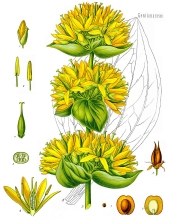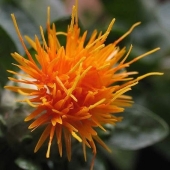Aloe, a Surprising Bitter Herb
https://southernappalachianherbs.blogspot.com/2020/11/aloe-surprising-bitter-herb.html

When I received my first batch of Swedish Bitters, I was quite surprised to find Aloe listed as the first ingredient. My mother and my grandparents always had a few aloe plants growing in a sunny window. That was our first aid for burns. I also knew of Aloe juice being used for stomach and digestive conditions and such. But, I never thought of it as a Bitter. I was especially surprised when I opened Maria Treben's classic, Health Through God's Pharmacy, to find that not only was Aloe listed as a primary herb in the Swedish Bitters, but it was listed that Gentian or Wormwood could substitute for Aloe... meaning that Aloe was THE primary Bitter!
The medicinal use of Aloe seems to originate in the ancient Middle East, where it is used both medicinally and in religious symbolism. Mrs. Grieves wrote in her A Modern Herbal:
The Mahometans, especially those in Egypt, regard the Aloe as a religious symbol, and the Mussulman who has made a pilgrimage to the shrine of the Prophet is entitled to hang the Aloe over his doorway. The Mahometans also believe that this holy symbol protects a householder from any malign influence.
In Cairo, the Jews also adopt the practice of hanging up the Aloe.
In the neighbourhood of Mecca, at the extremity of every grave, on a spot facing the epitaph, Burckhardt found planted a low shrubby species of Aloe whose Arabic name, saber, signifies patience. This plant is evergreen and requires very little water. Its name refers to the waiting-time between the burial and the resurrection morning.
In ancient Egypt, Aloe was known as a "Plant of Immortality" (
https://blog.aloecure.com/blog/aloe-vera-history) and aloe was mentioned by King Solomon in the Psalms, and for anointing Christ's body. "Greek physician, Dioscorides was the first Westerner to write about the plant’s benefits. Dioscorides learned about aloe while traveling with the Roman armies and wrote that aloe vera acted as a laxative and that it encouraged sleep." (
https://blog.aloecure.com/blog/aloe-vera-history). It is said that Cleopatra used Aloe in her beauty regimen and that Alexander the Great even battled over an island to secure its Aloe. Columbus brought Aloe to the New World, as it was a medicinal herb commonly used by Jesuit priests.
The Bitter flavor profile of aloe is evident in the meaning of its name. Aloe is said to have derived from an Arabic term meaning, "Shining Bitter Substance".... which is odd considering that one would have such limited use of a word with such a specific meaning... but, we'll go with that. A quick internet search turns up many articles such as "Why does Aloe taste so Bitter/bad?" and, "How to Mask Aloe's Bitter Taste." Apparently there is even a variety of Aloe bred to be less Bitter (Aloe ferox). But, for those of us who recognize the health benefits of Bitters and the medicinal actions of the very Bitter flavor, itself, we need not fear or alter our Aloe. It seems the Bitterness of the Bitter compounds in Aloe is dependent on an individual's taste; some describe it as "Bitter/sweet", while others find it to be among the most Bitter substances on earth.
But, how the heck do you transform the mucilaginous juice of Aloe into something one can use is dry herb formulas?
By 600 BCE, Arab traders had found a way to easily separate the gel part of the aloe plant from the rind. They did this by crushing the leaves and placing the pulp into goatskin bags to dry in the sun. The dried aloe was then powdered, which made it easy to transport to different parts of the East, including India and Persia. (
https://www.spiceography.com/aloe-vera/)
By the way, if you grow your own, be sure not to over water it. Aloe is a desert plant that likes hot, dry conditions, at least to a point.
So, lets get into the specific properties of Aloe via our regular source for brief, cogent and accurate herbal info, NaturalMedicinalHerbs.net:
Herb: Aloe Vera
Latin name: Aloe vera
Synonyms: Aloe barbadensis, Aloe vulgaris
Family: Aloeaceae (Aloe Family)
Medicinal use of Aloe Vera: Aloe vera is a fairly well known herbal preparation with a long history of use. It is widely used in modern herbal practice and is often available in proprietary herbal preparations. It has two distinct types of medicinal use. The clear gel contained within the leaf makes an excellent treatment for wounds, burns and other skin disorders, placing a protective coat over the affected area, speeding up the rate of healing and reducing the risk of infection. This action is in part due to the presence of aloectin B, which stimulates the immune system. To obtain this gel, the leaves can be cut in half along their length and the inner pulp rubbed over the affected area of skin. This has an immediate soothing effect on all sorts of burns and other skin problems. The second use comes from the yellow sap at the base of the leaf. The leaves are cut transversally at their base and the liquid that exudes from this cut is dried. It is called bitter aloes and contains anthraquinones which are a useful digestive stimulant and a strong laxative. When plants are grown in pots the anthraquinone content is greatly reduced. The plant is emmenagogue, emollient, laxative, purgative, stimulant, stomachic, tonic, vermifuge and vulnerary. Extracts of the plant have antibacterial activity. Apart from its external use on the skin, aloe vera (usually the bitter aloes) is also taken internally in the treatment of chronic constipation, poor appetite, digestive problems etc. It should not be given to pregnant women or people with haemorrhoids or irritable bowel syndrome. The plant is strongly purgative so great care should be taken over the dosage. The plant is used to test if there is blood in the faeces. This plant has a folk history of treatment in cases of cancer.
Known hazards of Aloe vera: None known
https://southernappalachianherbs.blogspot.com/
 6
6





 4
4








 2
2




 1
1











